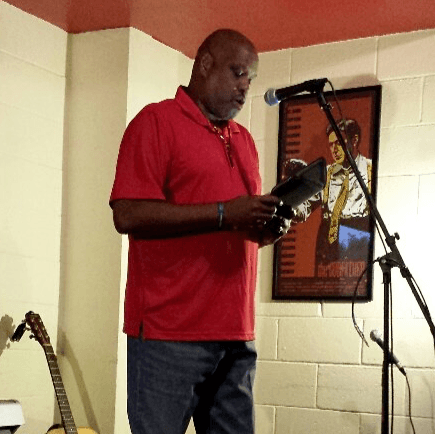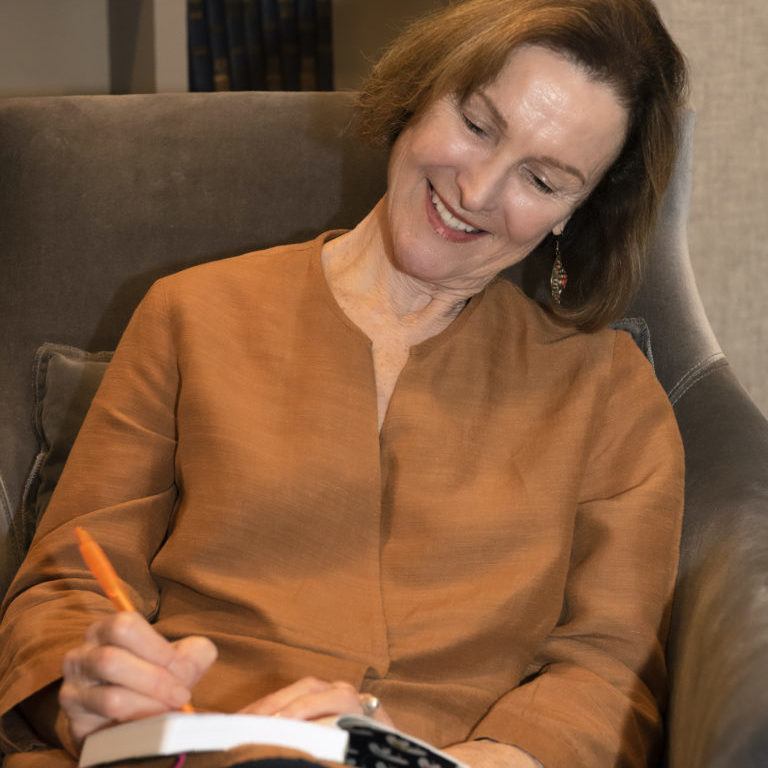What Writers Need to Know About Copyright Law
For Poets, Novelists, Screenwriters, Playwrights, Journalists, and Other Wordsmiths
We created this Copyright Law for Writers webpage to provide information about copyright law as it applies to poets, novelists, short story writers, journalists, bloggers, and other creators of written works.
On this page, we explain what rights writers have under copyright law, why it is important to register written works with the U.S. Copyright Office, and how to deal with copyright infringement. We also provide several resources for writers about copyrights in the writing and publishing contexts. Feel free to jump to a specific section:
- What Rights Do Writers Have?
- Should Writers Register Their Works with the U.S. Copyright Office?
- How to Know When a Written Work is Published or Unpublished?
- Do Writers Own the Copyright to the Works They Author?
- How Long Does Copyright Protection for a Written Work Last?
- Fair Use for Writers
- Copyright Infringement for Writers
- Common Copyright Law Questions for Writers
- Copyright Resources for Writers
What Rights Do Writers Have?
Copyright protection for literary works applies automatically when a work is originally authored and fixed in a tangible form, such as writing something down on paper or typing up a document and saving it on the computer. Copyright law does not protect facts, ideas, themes, or tropes used in written works, but instead protects the way these things are expressed in writing.
When a written work is protected under copyright law, the copyright owner has several exclusive rights: (1) the right to reproduce the work, (2) the right to distribute the work, (3) the right to create derivative works of the work, (4) the right to publicly perform the work and (5) the right to publicly display the work.
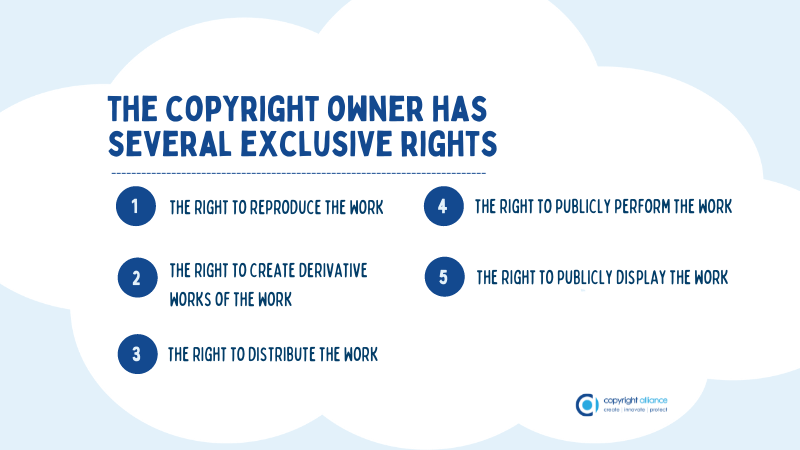
Should Writers Register Their Written Works with the U.S. Copyright Office?
As previously mentioned, copyright protection for written works begins as soon as the work is fixed in a tangible medium. Therefore, a writer does not need to register a written work with the U.S. Copyright Office for that work to be protected by copyright. However, there are many benefits to registering with the Office. These benefits include keeping a public record of the writer’s copyright so that others know who to seek permissions from if they want to use the work and preserving a writer’s ability to sue if copyright infringement occurs. More information about how to register literary works can be found on the Copyright Office’s literary works registration page.
In order to fully and correctly complete a registration application, a writer will need to know some important information about the work, such as:
- What type of work is being registered;
- Whether anyone else has a copyright ownership interest in the work;
- Whether the work has been published, and if so, when;
- Whether the work contains pre-existing materials.
Knowing these details and others will help the writer correctly complete the copyright registration application form and reduce delays in the registration process caused by any back-and-forth communication with the Copyright Office. In addition to completing the application, the applicant will also need to submit at least one copy of the written work along with a registration fee to the Copyright Office.
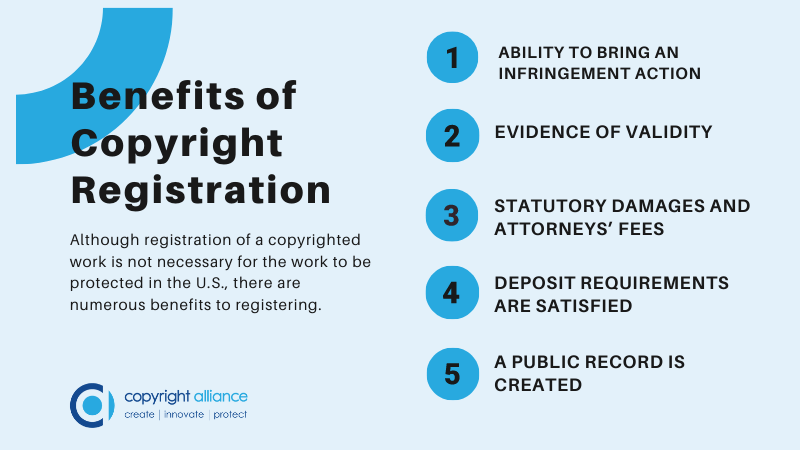
How to Know When a Written Work is Published or Unpublished?
Knowing whether a work has been published and what date it was published is important for many reasons. Writers need to know the publication status of a written work in order to completely and accurately submit a registration application to the Copyright Office and the publication year will be important to determining the term of copyright protection for an anonymous or pseudonymous work and for a work made for hire.
Under the Copyright Act, publication of a written work occurs when:
- the copyright owner distributes or authorizes someone else to distribute copies of the work to the public or;
- the copyright owner offers or authorizes someone else to offer to distribute copies of the work to a group of persons for the purposes of further distributing copies of, publicly performing, or publicly displaying the work.
Importantly, a public performance or display of a work does not itself constitute publication. For example, a blog post on a website is a public display of work and is therefore not considered to be published. However, if the blog post is not just displayed but is also distributed by, for example, allowing others to download it or including the blog post into a book that is sold in bookstores, then the blog post would be considered to be published.
When a copyright owner restricts distribution of copies of a work to a selected group with a limited purpose and without the right of anyone in that group to diffuse, reproduce, distribute, or sell the work that is considered to be a “limited publication.” A “limited publication,” is another way of saying that a work is unpublished. For example, a writer might send a copy of a written work to her agent or perhaps circulate copies to other writers to review, but unless the writer authorizes recipient(s) to further distribute copies of the work, the work would be considered by a “limited publication” and therefore be unpublished.
We completely understand if the distinction between published and unpublished is confusing. Even the foremost experts in copyright at the U.S. Copyright Office concede that the legal definition is extremely difficult to understand. We encourage writers to check out our Published v. Unpublished FAQ page and an answer from the Copyright Office about Published v. Unpublished Registrations for more information.
Do Writers Own the Copyright to the Works They Author?
At times, copyright ownership of written works can get confusing and a writer’s copyright interest can depend on many factors surrounding a particular creative project. A written work can have multiple authors, writers can license or assign works, or an employer might actually own the copyright in the written work as what is called a “work made for hire.”
To avoid confusion over ownership issues, at the beginning of any project it is important for writers to know their rights, understand the intent of all involved parties, memorialize any important agreements or understandings, and to carefully read over any agreements that may be presented to them.
Joint Authorship and Copyright Ownership
Jointly authored works are works where two or more creators contribute to a written work and the creators intend for their contributions to be inseparable from one another. In a joint work, each creator holds an undivided, equal share to the copyright in the written work. Thus, the default rule is that each creator has an equal claim to all the exclusive rights in the joint work—the right to reproduce, distribute, create derivative works, and publicly perform or display—unless they separately agree among themselves that the shares or division of rights or profits should somehow be different.
When writers contribute written works that they do not intend to be inseparable from a bigger, overall work, the overall work would be considered a collective work or a compilation. In a collective work or compilation, each author or copyright owner of an underlying, separable copyrighted work retains their copyright to that specific work. The rightsholder to the overall work would have a separate copyright in the overall work based on the selection, coordination, and assembly of the underlying works. The Copyright Act presumes that the rightsholder to the collective work or compilation has the right to reproduce or distribute the individual work so that it can be incorporated and used in the overall collective work or compilation.
Oftentimes, writers may collaborate with other writers, illustrators, editors, dramaturgs, and various experts when developing a certain work. In a collaboration, it is best to express and memorialize in a written contract whether the creative relationship is a joint authorship. Without an express agreement, writers may later find themselves arguing with one another over whether they all intended to be joint authors for copyright purposes.
Is the Work a Work Made for Hire?
A work is considered a work made for hire if it is:
(1) created by an employee within the scope of employment, or
(2) a special type of work (translations, contribution to a collective work, compilation, instructional text, test materials, atlas, etc.) which has been specially ordered or commissioned.
If the work falls within one of these two categories, the “author” of the work for copyright purposes is considered to be the employer or the person who commissioned or ordered the work. Thus, it is that entity or person, not the original creator of the work, who owns the copyright. For a further explanation about works-made-for-hire factors check out our Works Made for Hire FAQ.
Is the Work Being Licensed or Assigned?
If a work is not a work made for hire, the writer(s) can license or assign their rights to the work to third parties. The key difference between a license and an assignment agreement is that in a license agreement, the writer only grants permission or authorizes others to use certain rights to the copyrighted work versus an assignment agreement where the writer transfers or “gives away” the rights from the writer to a third party.
In assignment agreements, the writer is effectively no longer the copyright owner of the work, unless the writer terminates those rights. Under copyright law, copyright owners have termination rights which allows them to terminate both licenses or transfers (assignments) of one or more of the exclusive rights of the copyright owner between 35th and 40th year after the license or transfer agreement went into effect.
But keep in mind, that if there are joint authors (unless there is a separate agreement between all authors), each author has the equal right to license or assign his/her own rights to the work without permission from any of the other authors—as long as an accounting of profits is provided to the other authors. However, in the case where one of the authors of a joint work wants to grant an exclusive license (more on that below) of a right(s) to the joint work, this could impact and restrict the rights of the rest of the authors and so permission from the other authors would be needed.
Are the Rights in the Work Being Transferred Exclusively or Non-Exclusively?
An important concept that writers should be aware of relates to exclusivity provisions in license agreements. License agreements can have exclusive provisions, meaning the licensed third party is the only party who has the licensed right(s) (for example, the exclusive right to publish a work for three years or the exclusive right to create audiovisual works of the written work). In an exclusive license, the copyright owner gives the other party the entirety of the right(s) subject to the contract, and the copyright owner is effectively no longer the copyright owner of those rights.
License agreements can also have non-exclusive provisions meaning that the writer(s) can license that same right to other third parties or use the right themselves. Under a non-exclusive license, a writer could grant a third party one or more of the exclusive rights.
How Long Does Copyright Protection for a Written Work Last?
Copyright protection for a written work lasts for the life of the author plus an additional 70 years. If the written work is jointly authored, the copyright term lasts for life of the last surviving joint author plus an additional 70 years.
The term of protection is a bit different for works made for hire created by corporations or businesses as well as anonymous and pseudonymous works. That’s because for these types of works there is no “life” by which to measure the term. For these works, the term of copyright is 95 years from year of first publication or 120 years from year of creation of the work—whichever is shorter.
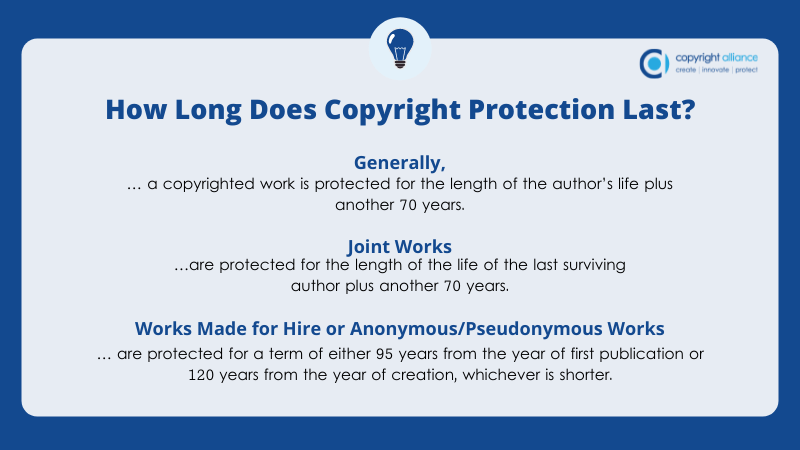
Fair Use for Writers
Fair use is an important exception in copyright law that allows writers and others to use a copyrighted work without the copyright owner’s permission and without paying the copyright owner. The Copyright Act provides several examples of what kinds of uses may qualify for the fair use exception, such as works of criticism, comment, news reporting, and scholarship. Ultimately, whether something qualifies as a fair use is determined on a case-by-case basis by balancing four factors:
- The purpose and character of the use, including whether such use is of a commercial nature or is for non-profit educational purposes;
- The nature of the copyrighted work;
- The amount and substantiality of the portion used in relation to the copyrighted work as a whole; and
- The effect of the use upon the potential market for or value of the copyrighted work.
All four of these factors have to be evaluated; no single factor can determine whether something is a fair use or not. The fair use exception can be a bit confusing to understand, but here are some pointers as writers think more holistically about fair use in the writing and publishing contexts:
Under Factor 1
- Works of parody are more likely to qualify for the fair use exception than a work of satire because they criticize or provide commentary on the underlying work. Check out our FAQ and a blog further discussing works of parody and satire in the fair use context.
- If a particular use of a copyrighted work is transformative, this would weigh in favor of a fair use finding. A transformative use is one in which the use has a fundamentally different purpose than from the purpose of the original underlying work and does not act as a substitute for the original use of the work. For example, some courts have found that where a copyrighted work or a portion thereof, is used to critically enhance historical information in a biographical work, the use can be found as sufficiently transformative. For example, the Second Circuit court in Bill Graham Archives v. Dorling Kindersley Ltd. found that a defendant’s use of copyrighted images of band concert photos and tickets in a historical timeline in a biographical book about the band was transformative because it “enhance[ed] the biographical information in [the defendant’s book], a purpose separate and distinct from the original artistic and promotional purpose for which the images were created.”
Under Factor 2
- Use of nonfiction or factual works may move the needle on this factor in favor of a finding of fair use, especially when the use is transformative under the first factor and when the unprotectable facts and ideas (which factual works contain more of) are the elements being used in the unauthorized work. To be clear, this does not mean that an unauthorized use of a nonfiction or factual work will always weigh in favor of fair use. Nonfiction and factual works still contain copyrightable expression, such that if the expression of the factual work is used, a court could find that the use was not a fair use. For example, excerpted subjective descriptions and portraits of public figures as expressed by the author in his memoir, were still considered to be very expressive, exceeding mere factual value. On the flip side, use of fictional works moves the needle on this factor in favor of a finding that the use is not a fair use since the user is very likely using copyrightable expressive parts of the underlying work.
- Use of an unpublished work would weigh this factor against a fair use finding. The Supreme Court emphasized that the right of an author or a rightsholder publication right to his or her work was critical to the rightsholder’s ability to exercise full creative and quality control over his or her work.
Under Factor 3
- If a small portion of the copyrighted work is used that may weigh in favor of fair use. There is no specific number or amount (e.g., 10% or 2 pages) of a copyrighted work that can be used as it is decided on a case-by-case basis. Even if only a small portion of a work is taken, the use may not qualify for the fair use exception if it takes the “heart” (i.e., fundamental, crucial expression) of the underlying work.
Under Factor 4
- A use that causes market harm to the underlying work would weigh against a finding of fair use. But it’s important that writers understand that courts will consider the kind ofmarket harm. If a work substitutes for the original work in a market for the original work, a court would weigh this factor against a finding of fair use. But if someone uses a copyrighted work in a criticism or review of the work, which drives the public away from purchasing the copyrighted work, this would not count as market harm for the purposes of analyzing the fourth fair use factor.
For additional guidance on how to consider the four fair-use factors and how it affects writers’ copyright interests, please watch Copyright Alliance’s fair use educational videos for free, or join our free membership to watch in-depth webinars on fair use.
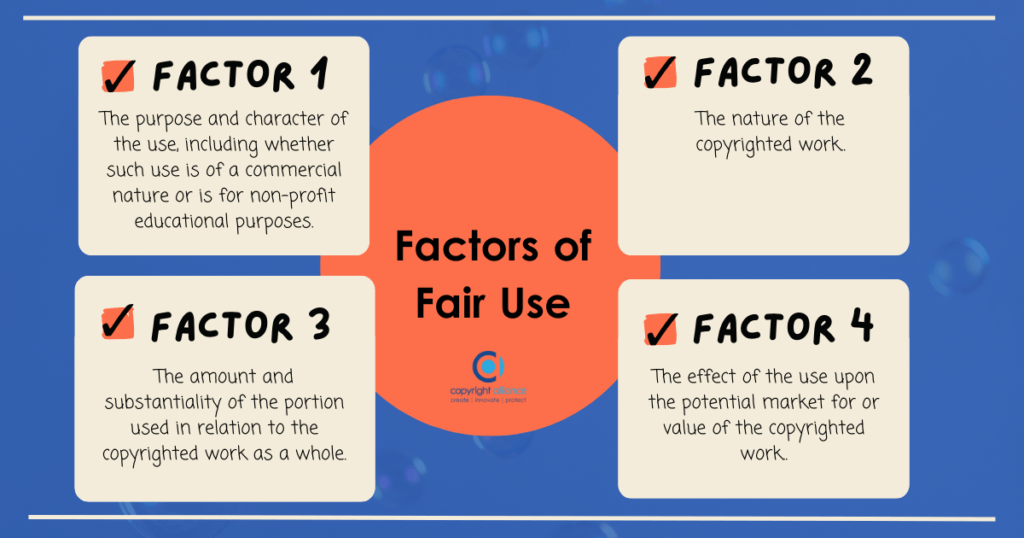
Copyright Infringement for Writers
Copyright infringement occurs when someone engages in using one or more of a copyright owner’s exclusive rights without the owner’s permission and there is no exception or limitation in the copyright law that otherwise allows for that particular use. The infringing act might be innocent, but that doesn’t excuse the fact that it is implicating someone else’s rights.
Copyright infringement for writers can take on all sorts of shapes and forms, but again, when evaluating whether infringement has occurred, the writer must remember that exceptions like fair use might excuse that otherwise infringing activity. Additionally, a writer should also remember that copyright law protects expressions and not ideas and therefore it does not protect general plot or storylines, historical or scientific facts, data points, themes, ideas, and character tropes.
Once a writer determines that the material is indeed an infringement of the writer’s copyrighted work, there are some steps the writer can take to try to stop the infringement and/or get compensated by the infringer. The writer can contact the infringer directly to request that the infringer cease the infringing activities, take down the infringing material (if its online), and/or be compensated for the infringing use (including and damages incurred by the writer). If contacting the infringer directly does not work, the writer may consider sending a Digital Millennium Copyright Act (DMCA) takedown notice to the platform that is hosting or linking to the infringing material and ask for it to be taken down and/or to sue the infringer in federal court or the Copyright Office’s small claims court.
Sending a DMCA Takedown Notice
If a writer discovers that their work is being infringed on a web service or platform (and the writer determines that there are no other copyright law exceptions that apply (like fair use), they can send a DMCA takedown notice to the online platform or service where the infringing material is found, requesting that the material be taken down. For example, if an infringement is found on Facebook, the writer could send a DMCA notice to Facebook by filing out an online form requesting the infringing materials be taken down. The DMCA Takedown Notice process does not guarantee the infringer will stop the infringing activity. But at a minimum, it does put the infringer on notice that they are making use of a copyrighted work without the copyright owner’s consent.
There are a number of elements that should be included within the notice, such as a signature, contact information, and identification of the work being infringed upon. It is important to know what a DMCA takedown notice should include. Many popular social media platforms and online service providers will have their own DMCA forms and tools that writers can use to enforce their copyrights.
Suing the Infringer
If the infringer refuses to take down the material and the platform or online service provider agrees with the infringer, then the only way for the writer to get the infringing material removed (and to get damages stemming from the infringement) is to sue the infringer in federal court. Federal courts have jurisdiction over copyright infringement cases, which means that a writer cannot bring a claim in state court. As discussed before in the registration section, writers should remember that in order to sue in federal court, the U.S. Copyright Office must have made a registration determination regarding the writer’s work.
As an alternative to suing in federal court, a writer can sue for infringement in the small claims court located within the U.S. Copyright Office. The small claims court, which is called the Copyright Claims Board (CCB), can award damages, but cannot order the infringer to stop (unless the infringer agrees). There are other differences between federal court and the small claims court, including the fact that the infringer can opt-out (in which case the writer’s claims will be dismissed) and that there is a cap on damages. Learn more about the copyright small claims court process on our FAQ page about the CCB.
Common Copyright Law Questions for Writers
Can a Work be Used Without Permission if Credit to the Author is Given?
Giving credit for the use of someone else’s work is a great way to avoid committing plagiarism, but it has no impact on copyright infringement. Infringement is infringement, whether credit is provided or not. Learn more from our blog about Plagiarism and Copyright
Can a Book Title Be Protected by Copyright?
Since copyright law protects the original, fixed expressions—a book title, list of ingredients in a cookbook, or similarly situated short phrases or lists of procedures may not contain enough of that original, creative expression. As a result, book titles and other short phrase are almost never protected by copyright. However, in some cases, they may be protected by trademark law. For more discussion on what copyright law does not protect, check out our Copyright Law Explained page and our FAQ to a question related to this topic.
How can Images, Videos, and Other Content in Blogs or Other Online Written Works be Used Legally?
If a use doesn’t qualify for an exception like fair use, usually, asking the copyright owner of the work is the best way to legally incorporate other works in a blog or other forms of written works online. There are also other ways of finding content to legally incorporate into a blog or other online written works. Just check out our blog on this topic for additional tips and guidance.
There are a number of ways to stay informed about how copyright law works for writers and the publishing industry in general. For starters, we recommend that creators join the Copyright Alliance for free and visit the U.S. Copyright Office’s website.
Copyright Resources for Writers
Copyright Law FAQs by the Copyright Alliance
- Do I have to use my legal name to register a work?
- Several poems from my book were previously published, should these poems be registered individually?
- If an image is inside of a registered work, like a book, is the image also registered? Similarly, if the registered book required a renewal registration, is the image’s registration also renewed?
- At what point in the creative process do you register a copyrighted work that is continuously being updated or revised, like a screenplay?
- Does the Copyright Office continue to recommend including content titles for their unpublished works?
- If a creator uses works in the public domain (e.g. Shakespeare play, the Bill of Rights, etc.), how does this affect the copyright registration application process?
- What rights do I have to prevent my co-writer to change our copyright registration?
- What is the difference between “Published” vs. “Unpublished” works, why does it matter, and how does the difference relate to Online vs. Print publishing?
- What is the Copyright Office policy regarding registration of published and unpublished works?
- What is the Copyright Office’s definition of “published”?
- I found an article in an online newspaper that I want to share with my colleagues. Can I copy and paste the article into my company’s internal newsletter or upload it onto the company’s intranet?
- Can I post or upload news articles from an online publication that I subscribe to onto my company’s intranet or network?
Other Copyright Resources for Writers
- Literary Works Registration | U.S. Copyright Office
- Where the Authors Guild Stands on Copyright | The Authors Guild
- Writer’s Legal Guide | The Authors Guild
- Writers’ Resource Library | The Authors Guild
- Discussion Forums | Independent Book Publishers Association
- Policy Priorities for the Association of American Publishers | AAP
- Copyright Information for Writers | Poets & Writers
- Copyright Management Suite of Tools | RightsClick
- Find a Copyright Attorney | Copyright Alliance
- Find a Volunteer Lawyer for the Arts Group | Copyright Alliance
Writer Creator Spotlight Blogs
The Copyright Alliance created the Creator Spotlight blog series to highlight creators’ careers and the copyright challenges they have faced. Below are some of the creator spotlight blogs that feature authors and writers:
YOU can participate in our Creator Spotlight Blog series too. Read these instructions to be featured!
We will continue to update this page as more resources become available on copyright law for writers, so keep checking back.
Individual creators, such as writers, can join our copyright community for free to stay up to date with all things copyright.





